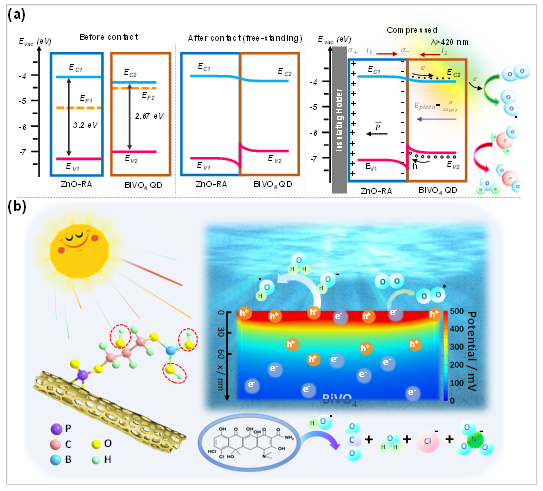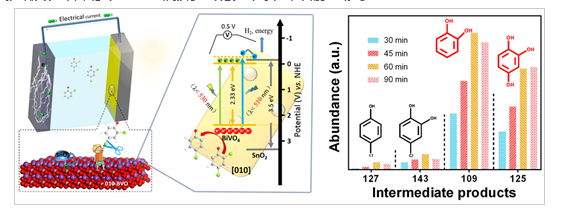Photo-catalytic or electro-catalysis oxidation technology, mainly driven by luminous energy, can deeply remove trace pollutants in water and air.The photocatalyst material is the core element of the catalytic reaction, thecharacters of which directly determine the degradation efficiency of pollutants. Among them, thecharacter of photo-generated carriers is one of the most critical influence factors. Usually narrow band gap oxides having better light absorption properties and chemical stability are ideal photocatalyst materials. But they also have the disadvantage that photogenerated carriers are easily recombined, resulting in low catalytic efficiency.
Recently, Associate Professor Xie Mingzheng's research team has made some progress in exploring new strategies for improving the efficiency of narrow band gap oxide photocatalysts to degrade environmental pollutants.The reasons for the low separation efficiency of photogenerated carriers are differences in different reaction systems.In general, the low conduction band energy level and the short carrier transmission distance are the common reasons that lead to the easy recombination of photogenerated carriers of narrow band gap oxide materials. To solve this problem, the research team explored the electric field control strategy based on the piezoelectric effect and surface polarization, optimized the energy level structure of the catalyst material and the carrier transport behavior and enhanced the participation of photogenerated electrons and holes in photocatalysis from the perspective of thermodynamics and kinetics. In addition, the degradation path of pollutants, to some degree, also affects the catalytic efficiency.The research team obtained efficient removal of contaminants (chlortetracycline and chlorophenol) by regulating the generation of key active species and interfacial adsorption properties. Besides, Chlorophenol could be converted into phenols with higher economic value through selective dehalogenation mainly led by holes.
The above studies were published respectively in the Nano Energy, Chemical Engineering Journal andACS Applied Materials & Interfaces in the field of environment and energy catalysis in the first half of 2020. And the College of Earth and Environmental Sciences, Lanzhou University, is the first labeling institution. The research was supported by the National Natural Science Foundation of China and the Young Science and Technology Talent Lifting Project of Gansu Province. The School of Physical Science and Technology, Lanzhou University and Heilongjiang University Key Laboratory of Functional Inorganic Materials Chemistry, the Ministry Education of are cooperating institution.
The article links:
https://www.sciencedirect.com/science/article/pii/S2211285520300045(Energy and separation optimization of photogenerated charge in BiVO4quantum dots by piezo-potential for efficient gaseous pollutant degradation, Nano Energy, 2020, 69: 104448)
https://www.sciencedirect.com/science/article/pii/S1385894720319999(Accelerated generation of hydroxyl radical through surface polarization on BiVO4microtubes for efficient chlortetracycline degradation, Chemical Engineering Journal, 2020, 400: 125871)
https://pubs.acs.org/doi/10.1021/acsami.0c06892(Ultrafine SnO2/010 Facet-Exposed BiVO4Nanocomposites as Efficient Photoanodes for Controllable Conversion of 2,4-Dichlorophenol via a Preferential Dechlorination Path, ACS Applied Materials & Interfaces, 2020, 12: 28264-28272)

Fig.1 Separation, transport and reaction of photo-generated carriers under the action of carbon fluoride and surface polarization

Fig.2 Selective conversion of chlorophenols based on preferential reaction of photogenerated holes